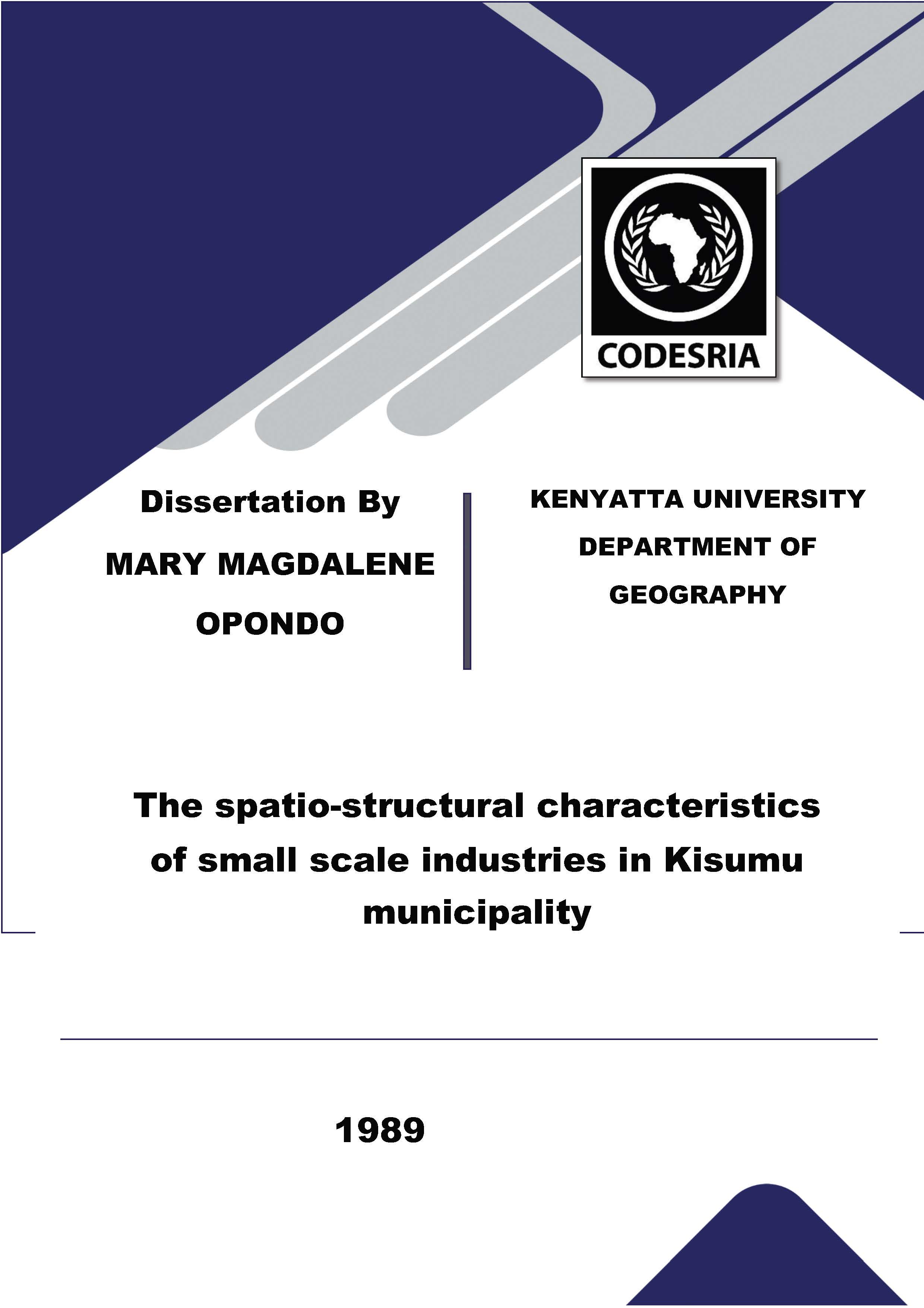The spatio-structural characteristics of small scale industries in Kisumu municipality
Keywords:
Small-scale industry, location of industry, industry, entrepreneurs, economic aspects, location factors, KisumuSynopsis
The analysis is as varied as the study's objectives. First a descriptive
analysis based on primary and secondary sources of data is undertaken in
order to elucidate the structural features. Second, factor analysis employing
the principal component technique is used to identify the most significant
factors that motivate entrepreneurs to establish small scale manufacturing
firms in Kisumu. Third, a multiple regression analysis employjng the
stepwise selection procedure and factor analysis are performed to
determine which factors strongly influence the intra-urban distribution of
small scale manufacturing industries. Finally, a simplified input-output
technique is used to establish the capital equipment, raw material and
market spatial linkages of the small scale manufacturing industries. For
research premise 1 and hypothesis 4, a sample of 197 industries was
examined, whereas for hypotheses 2 and 3, a sample of 142 was used. The
results of the multiple regression analysis are significant at (P<0.00001).
The study reveals that the informa! industrial units are far more
numerous thç1.n the forma! small scale firms. The informa! industrial
units have distinct characteristics from their forma! counterparts.
The investigation on entrepreneurial perception. reveals that, in
general, the factors which motivate entrepreneurs to establish industries
in Kisumu are, agglomeration, industrial infrastructure, business
information, and persona! considerations. On the other hand, the
variables determining the intra-urban spatial pattern of small scale
manufacturing firms are, mainly persona! considerations such as
proprietor lives here and nearness to home and hence familiarity of area.
At the same time there are some economic factors such as proximity to
market, that play an influential though not determinant role.
The study also shows that the technological, subcontracting and
market inter-firm linkages are not very significant among the small scale
industries. On the other hand, there are strong raw material inter-firm
linkages. The spatial linkages indicate that the small scale industries,
particularly the forma! ones have greater capital equipment linkages with
the Rest of the World whereas the înformal industrial units have strong
linkages with the Local Area. The spatial raw material linkages with the
Local Area and forward linkages with the Rest of the Country are generally
.strong.
Downloads
References
A Basic Needs Strategy for Development'. 1977. Report of the DirectorGeneral, ILO. Development Digest. Vol. XV. No.1. January.
Aboagye, A.A. 1986. ILO Report: Informai Sector Employment in Kenya.
Alonzo, W. 1968. 'Urban and Regional Imbalances in Economie Development'. J. of Economie Development and Cultural Change, Vol.17. pp.1-14.
Awuor, R.0. 1979. 'Relationship of Kisumu's Industrial Sector to the Resource Hinterland: A Case Study of Kisu~u·s Cotton Mills'. Unpublished M.A. Thesis, U.0. Nairobi.
Barker, E.E. 1958. A Short History of Nyanza. Nairobi: East African Literature Bureau. Barr, B.M. and K.J. Fairbain. 1978. 'Linkage and Manufacturers' Perception of Spatial Economie Opportunity' in F.E.I. Hamilton. ed.
Contemporary Industrialization and Regional Development.
London: Longman. pp.122-143.
Bassi-Zambelli, D. 1982. 'Technical Report: Small Industries Sector - its present situation and prospects for development'. UNIDO. Vienna.
Bater, J.H. and D.F. Walker. 1970. 'Further Comments on Industrial Location and Linkage'. Area. Vol.4. pp 59-63.
Berry, B.J.L. 1960. 'An Inductive Approach to Regionalization of Economie Development' in N. Ginsburg. ed. Essays on Geography and Economie Developrnent. Chicago: University of Chicago.






